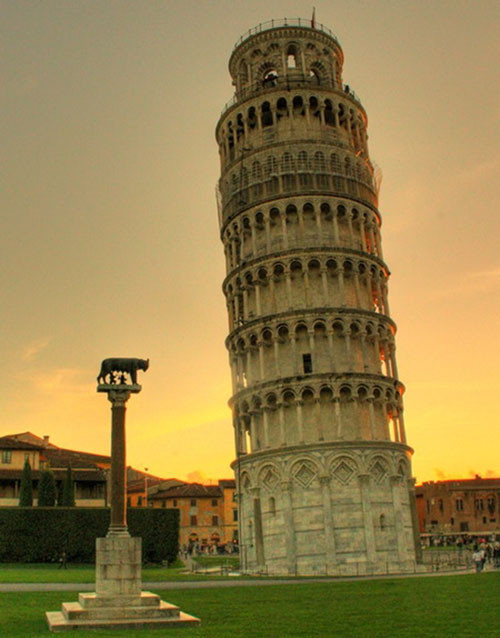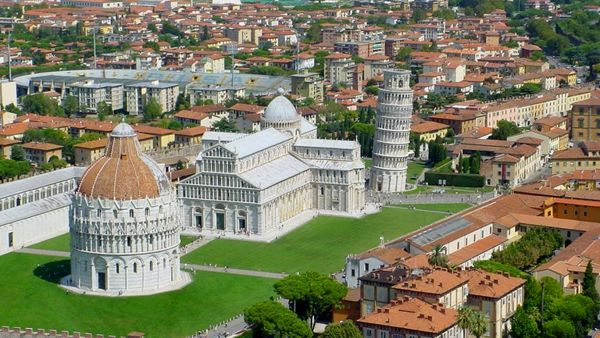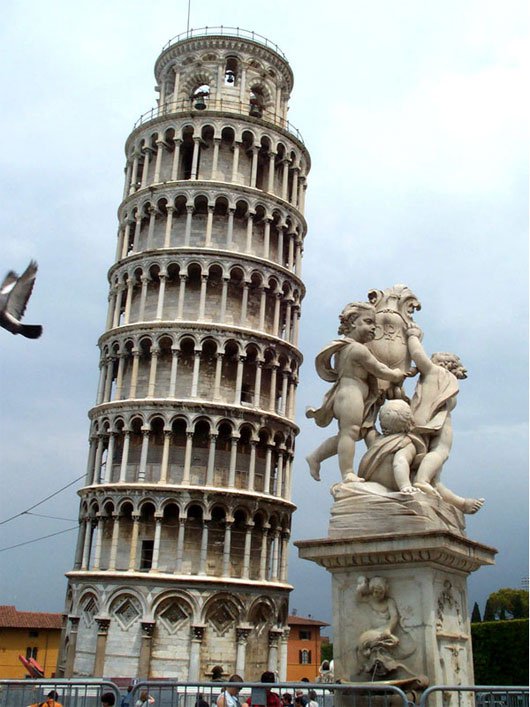Pisa leaning tower - The most unique architecture on the planet
Pisa's leaning tower in Italy is a world famous building. Originally the tower was erected vertically but due to the area of land that Pisa was 'reigning', it gradually subsided, so the tower became increasingly inclined. And it was this unintended inclination that made Pisa famous all over the world, even becoming a world wonder and recognized by UNESCO as a cultural heritage.
- 11 mysterious ancient buildings in the world that challenge the scientific world
- 7 underground works overwhelmed you
- 10 most beautiful world heritage in Asia you can not ignore

The Pisa Tower began construction on August 9, 1173.
Pisa leaning tower designed by architects Mugahe and Australian Borna Nasi. On August 9, 1173, the construction began construction and it took nearly 200 years, until 1350 it was completed.
When building to the third floor, the Tower of Pisa began to tilt. The reason is that the tower was built on the foundation of a leveled river whose foundation was dug deep, shallow ground. All measures to keep the tower balanced have no results, one must finally stop construction.

It was not until nearly a century later that the leaning tower continued to be constructed. Architect Giovanni di Simone was assigned this responsibility, and then the tilt on the third floor of the tower was up to 90 cm.
Simone sought to reduce the weight of the upper part of the tower, choose a lighter material, leaving the gap in the wall, the higher the emptiness, the higher the void. But by 1278, when the construction went to the seventh floor, the reconstruction had to be halted because of the war.

Until 1350, the new Pisa tower was completed, 55.86m high with 8 floors and 294 steps from the ground to the top and shaped like what we are seeing today. A special feature is that the leaning tower does not have a top floor, the bell tower is more vertical than the rest of the tower.
Pisa's leaning tower is located on the Campo dei Miracoli complex in Pisa, Italy, consisting of 4 very important cathedrals (Duomo), bell tower (Campanile - leaning tower), Baptism hall and cemetery (Camposanto).

In 1590, Galileo Galilei, the great Italian scientist who chose the Tower of Pisa, was the place to conduct the famous experiment of free-falling animals. From the top of the tower, he dropped two objects of different weight. As a result, they landed at the same time, from which he gave the famous physical theory: the mass of the object does not affect the falling acceleration of the object, meaning that heavy or light objects fall at the same speed.

During the Second World War, Nazi Germany took Pisa as an observatory and shelter. Thankfully Tower of Pisa still resiliently survived the bombs. In the 1990s, the Pisa tower tilted an extra millimeter each year, causing the city government to slash 30 million euros into repairs. People had to relocate 70 tons of land at the slant and replace it with cement with lead to increase the stamina for the tower.
Engineer Michele Jamiolkowski, who is in charge of Pisa's leaning tower conservation project, said it is likely that Pisa will tilt each year more until it collapses in about 300 years.
You should read it
- 10 most beautiful world heritage in Asia you can not ignore
- Watch the ice-cream tower with a fun dress
- Evaluation of fan quality of Unold 86890 tower of Germany
- Reviews on the Tower of the Approval - Together 'to the top'
- List of 10 tallest skyscrapers in the world today
- Tower of Fantasy: a mobile game that competes with Genshin Impact
- Problem of Hanoi Tower (Tower of Hanoi)
- Why the foundation of the world's tallest tower Burj Khalifa must be powered 24/7
May be interested
- What is tower fan? 5 advantages of tower fan compared to traditional tree fan?
 currently, there are tower fans on the market and are believed by everyone. what is tower fan? what are the advantages compared to traditional fans? refer to below
currently, there are tower fans on the market and are believed by everyone. what is tower fan? what are the advantages compared to traditional fans? refer to below - The difference between a mid tower and a full tower computer case
 you are ready to build the next computer configuration but not sure what type of computer you need to use? join tipsmake.com to find out the difference between the case of the mid tower computer and the full tower in this article!
you are ready to build the next computer configuration but not sure what type of computer you need to use? join tipsmake.com to find out the difference between the case of the mid tower computer and the full tower in this article! - Tower of Fantasy: a mobile game that competes with Genshin Impact
 how does tower of fantasy configure the game? when will tower of fantasy come out? link download game tof. open world game content
how does tower of fantasy configure the game? when will tower of fantasy come out? link download game tof. open world game content - Test of computer architecture P5
 in this test, the network administrator will continue to send you a multiple-choice questionnaire on computer architecture. hopefully, with the following questions, readers will be given more useful knowledge about this topic.
in this test, the network administrator will continue to send you a multiple-choice questionnaire on computer architecture. hopefully, with the following questions, readers will be given more useful knowledge about this topic. - Top 7 electronic lesson planning software
 software for developing electronic lesson plans helps teachers easily draft lectures more.
software for developing electronic lesson plans helps teachers easily draft lectures more. - The mysterious 9th planet could be a 'free floating' planet
 the 9th planet even contains more strange things than what astronomers once thought. let's learn about the mysterious 9th planet that can be a free planet!
the 9th planet even contains more strange things than what astronomers once thought. let's learn about the mysterious 9th planet that can be a free planet! - New giant exoplanet discovered 400 light years from Earth, with many strange features
 a unique gas giant planet has been confirmed through a global collaborative effort, providing new insights into planet formation and paving the way for future atmospheric research.
a unique gas giant planet has been confirmed through a global collaborative effort, providing new insights into planet formation and paving the way for future atmospheric research. - Full Code All Star Tower Defense 6/2024 updated daily
 our full list of all star tower defense codes are all new dynamic codes for the astd game, players can use them to redeem gems, gold and rare mega tower rewards.
our full list of all star tower defense codes are all new dynamic codes for the astd game, players can use them to redeem gems, gold and rare mega tower rewards. - The latest All Star Tower Defense 2021 Code
 code all star tower defense will give you more gems, exp and sometimes character skins. some of the latest all star tower defense giftcodes below will give players the above items.
code all star tower defense will give you more gems, exp and sometimes character skins. some of the latest all star tower defense giftcodes below will give players the above items. - Tower of Fantasy tips for beginners
 tower of fantasy tips for beginners, tower of fantasy tips for newbies, making the overall experience smooth, navigating the world
tower of fantasy tips for beginners, tower of fantasy tips for newbies, making the overall experience smooth, navigating the world










 The 15-year-old girl lost her life because of her hair-eating syndrome
The 15-year-old girl lost her life because of her hair-eating syndrome The asphalt pavement heaved as if breathing after the terrifying earthquake in Mexico
The asphalt pavement heaved as if breathing after the terrifying earthquake in Mexico Sugar not only affects your weight, but also mental health
Sugar not only affects your weight, but also mental health Mango trees are 1m high with 800 fruits in Japan
Mango trees are 1m high with 800 fruits in Japan Technical procedure for selecting and incubating chicken eggs by machine
Technical procedure for selecting and incubating chicken eggs by machine 14-year-old girl suffering from 'scoliosis' is cured by new medical technology
14-year-old girl suffering from 'scoliosis' is cured by new medical technology